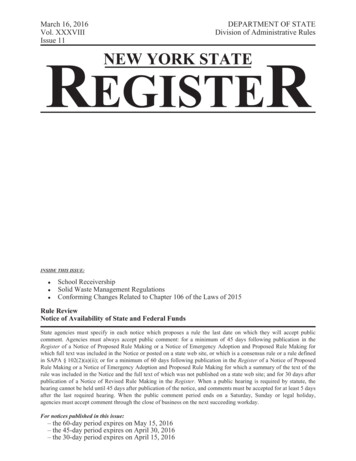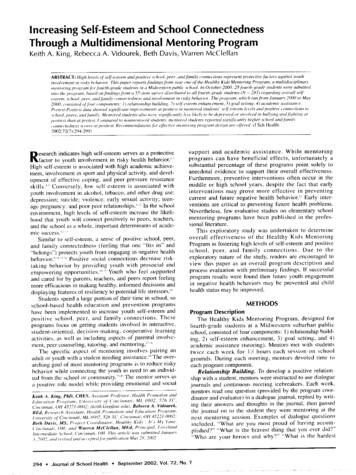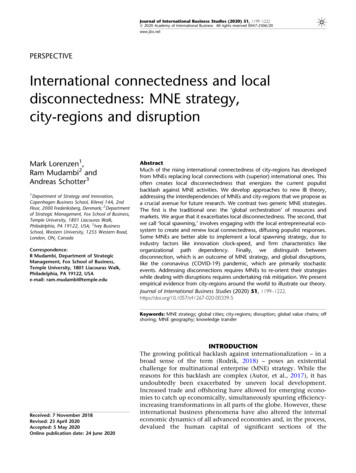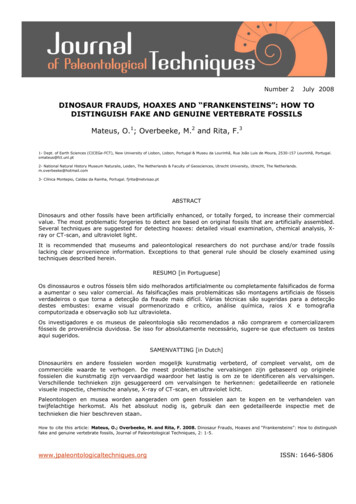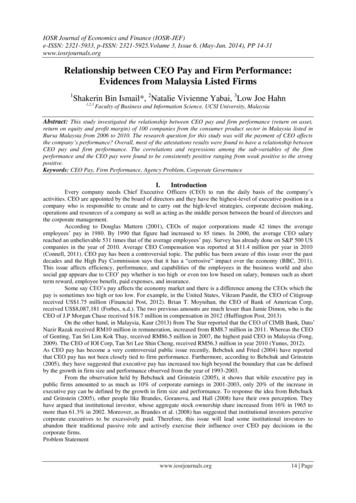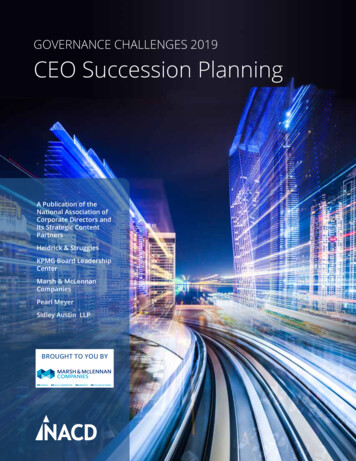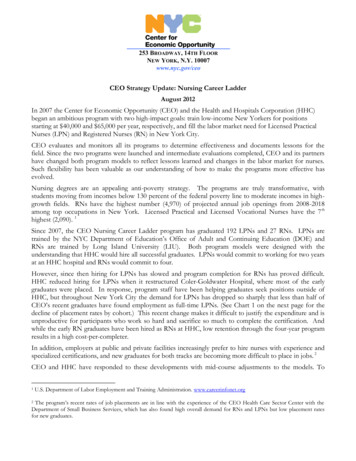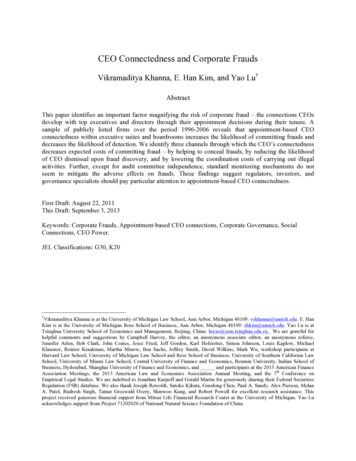
Transcription
CEO Connectedness and Corporate FraudsVikramaditya Khanna, E. Han Kim, and Yao Lu†AbstractThis paper identifies an important factor magnifying the risk of corporate fraud – the connections CEOsdevelop with top executives and directors through their appointment decisions during their tenure. Asample of publicly listed firms over the period 1996-2006 reveals that appointment-based CEOconnectedness within executive suites and boardrooms increases the likelihood of committing frauds anddecreases the likelihood of detection. We identify three channels through which the CEO’s connectednessdecreases expected costs of committing fraud – by helping to conceal frauds, by reducing the likelihoodof CEO dismissal upon fraud discovery, and by lowering the coordination costs of carrying out illegalactivities. Further, except for audit committee independence, standard monitoring mechanisms do notseem to mitigate the adverse effects on frauds. These findings suggest regulators, investors, andgovernance specialists should pay particular attention to appointment-based CEO connectedness.First Draft: August 22, 2011This Draft: September 3, 2013Keywords: Corporate Frauds, Appointment-based CEO connections, Corporate Governance, SocialConnections, CEO Power.JEL Classifications: G30, K20†Vikramaditya Khanna is at the University of Michigan Law School, Ann Arbor, Michigan 48109: vskhanna@umich.edu. E. HanKim is at the University of Michigan Ross School of Business, Ann Arbor, Michigan 48109: ehkim@umich.edu. Yao Lu is atTsinghua University School of Economics and Management, Beijing, China: luyao@sem.tsinghua.edu.cn. We are grateful forhelpful comments and suggestions by Campbell Harvey, the editor, an anonymous associate editor, an anonymous referee,Jennifer Arlen, Bob Clark, John Coates, Jesse Fried, Jeff Gordon, Karl Hofstetter, Simon Johnson, Louis Kaplow, MichaelKlausner, Reinier Kraakman, Martha Minow, Ben Sachs, Jeffrey Smith, David Wilkins, Mark Wu, workshop participants atHarvard Law School, University of Michigan Law School and Ross School of Business, University of Southern California LawSchool, University of Miami Law School, Central University of Finance and Economics, Renmin University, Indian School ofBusiness, Hyderabad, Shanghai University of Finance and Economics, and and participants at the 2013 American FinanceAssociation Meetings, the 2013 American Law and Economics Association Annual Meeting, and the 7th Conference onEmpirical Legal Studies. We are indebted to Jonathan Karpoff and Gerald Martin for generously sharing their Federal SecuritiesRegulation (FSR) database. We also thank Joseph Rewoldt, Satoko Kikuta, Guodong Chen, Paul A. Sandy, Alex Pierson, MelanA. Patel, Rudresh Singh, Tamar Groswald Ozery, Shinwoo Kang, and Robert Powell for excellent research assistance. Thisproject received generous financial support from Mitsui Life Financial Research Center at the University of Michigan. Yao Luacknowledges support from Project 71202020 of National Natural Science Foundation of China.
I. INTRODUCTIONAccusations of corporate and securities fraud dominated headlines over the last decade. Corporatewrongdoing damages investor confidence, hurts shareholder value, causes misallocation of capital, andincreases financial market instability,1 leading a number of scholars to examine factors affecting thelikelihood of fraud and its detection. Largely absent from these inquiries, however, is the role played bythe CEO’s connections with other corporate leaders.2 CEOs have substantial “soft” influence, along withexplicit legal authority, within the firm to direct corporate behavior, of which wrongdoing is but onepotential outcome.3 Moreover, this “soft” influence is likely to be strengthened by the CEO’s internalconnections.CEO connections with other top executives and directors could increase or decrease the incidenceof corporate fraud. As with other corporate activities, corporate wrongdoing often requires coordinationbetween, or acquiescence by, top executives and/or board members. The coordination and acquiescencecan be in the form of direct involvement in criminal activities or a reluctance to “blow the whistle.”CEOs’ close connections may help obtain the necessary support and thereby facilitate wrongdoing.However, it may also help deter frauds. The CEO’s familiarity with other top executives may enable himto detect early signs of fraud. Or when a CEO is unaware or uncertain about the illegality of certainactivity, a common problem in some areas of white collar crime, closer interpersonal relationships couldmake it easier for other executives and board members to provide friendly information to the CEO to help1See Karpoff and Lott (1993); Beatty, Bunsis, and Hand (1998); Bhagat, Bizjak, and Coles (1998); Karpoff, Lee, and Vendrzyk(1999); Bar-Gill and Bebchuk (2002); Karpoff, Lee, and Martin (2008a); Karpoff, Lee, and Martin (2008b); Gande and Lewis(2009); Murphy, Shrieves, and Tibbs (2009); and Karpoff, Lee, and Martin (2010).2A notable exception is Chidambaran, Kedia, and Prabhala (2012), who study how CEO-board network ties are related to fraudlikelihood.3Evidence on the importance of CEO influence on firm behavior and performance includes Graham, Harvey, and Puri (2013)who show CEOs’ behavioral traits such as optimism, risk-aversion, and time preference are related to corporate financial policiesand managerial compensation; Bertrand and Shoar (2003) who find CEO characteristics matter for a wide range of firm policies;Bennedsen, Perez-Gonzalez, and Wolfenzon (2006) who document that CEO deaths are strongly negatively correlated with firmprofitability and growth; Cronqvist, Makhija, and Yonker (2012) who show differences in corporate financial leverage can betraced to CEOs’ personal leverage; and Jenter and Lewellen (2011) who find CEO age approaching retirement has an importantimpact on the likelihood of their firms being taken over and the takeover premiums their shareholders receive. See Allen,Kraakman, and Subramanian (2012) for discussion of CEOs’ legal authority to contractually bind the firm for ordinarytransactions.1
avoid wrongdoing. Further, the CEO’s close connectedness could make it easier to stamp out fraud fromwhich the CEO does not anticipate personal gains. That is, CEO connectedness can cut both ways, andwhich effect prevails is an empirical question meriting further investigation.We consider two sources of CEO connectedness to top executives and directors: appointmentdecisions and prior network ties. We also examine proxies for CEO power (e.g., whether the CEO: is theFounder of the firm; is Board Chair; is a long-serving CEO; owns a substantial amount of stock) becausethe power relationship with other corporate leaders may also influence fraud. Of these three possiblesources of connections and influence, we find the one warranting particular attention for fraud preventionand detection is the least obvious – the fraction of top corporate leaders appointed during the current CEO’stenure. It has strikingly strong effects on all aspects of fraud, regardless of whether the connection is builtthrough appointments of top executives or directors. In contrast, network ties and CEO power haveconsiderably weaker effects on fraud.Appointment-based CEO connectedness is significantly associated with not only greater fraudlikelihood, but also with lower expected costs of engaging in fraud: it decreases the likelihood of frauddetection, lengthens the time from fraud commission to its detection, reduces the likelihood of forced CEOturnover upon discovery of fraud, and lowers the coordination costs needed to carry out illegal activities.Moreover, except for audit committee independence, we find little evidence that other standard monitoringmechanisms ameliorate the impact of appointment-based CEO connectedness.Connectedness built through appointment decisions increases what social psychologists refer to associal influence. It relies on norms of reciprocity, liking, and social consensus to shape group decisionmaking processes (Cialdini, 1984) and, hence, facilitates the acquiescence or coordination required toengage in fraud and keep it from view. When more top executives are appointed during a CEO’s tenure, theCEO’s social influence increases because CEOs are heavily involved in recruiting, nominating, andappointing top executives and in deciding their compensation. Thus, top executives are more likely to sharesimilar beliefs and visions with, and may be beholden to, the CEO who hired or promoted them to their2
current positions than executives appointed during a previous CEO’s tenure (Landier, Sauvagnat, Sraer, andThesmar, 2013; Kim and Lu, 2013). CEOs also tend to be involved in recruiting board members eitherdirectly or indirectly through consultation with the nominating committee; thus, directors recruited during aCEO’s tenure may similarly be beholden to the CEO (Morse, Nanda, and Seru, 2011; Coles, Daniel, andNaveen, 2011).4We find, however, CEOs’ prior network connections with top executives and directors do notfacilitate fraud as effectively as appointment-based connections. CEOs’ prior network ties with topexecutives are mostly unrelated to fraud, and no CEO-board network ties are significantly related to thelikelihood of detection. On the likelihood of fraud incidence, we find the same mixed effects identified inChidambaran et al. (2012): Fraud probability decreases with professional connections through pastemployment overlaps but increases with nonprofessional social ties. We argue appointment-basedconnections have stronger effects on fraud than network ties because when one is appointed to a topexecutive position or recommended to the board by a CEO, she may feel a greater sense of loyalty to theCEO. Such a loyalty factor is likely to be weaker when the connection is through network ties. One mayeven argue sharing similar education or work experiences can breed a sense of competition that may not fitas comfortably with loyalty.Our measures of CEO power follow the approaches used in previous studies: Whether the CEOchairs the board, is a founder, owns a large number of shares, and/or has served for a long time as CEO.These power variables, or their composite index, are mostly unrelated to fraud. CEO power is about theability to exert one’s own will on others – a mostly one-way influence that is easier to resist if the intendedaction or inaction is against the law (i.e., wrongdoing). It does not necessarily reflect the ability toencourage voluntary cooperative behavior among a group of individuals, which is often needed for fraud.4The literature on frequency dependent equilibria (see Andvig (1991); Bardhan (1997)) has some similarities with the socialinfluence literature.3
Social influence arising from appointment-based connectedness, by contrast, is about two-way relationshipsconducive to voluntary cooperative behavior, including fraud.Our sample covers 17,797 firm-year observations associated with 2,736 unique firms during theperiod 1996 through 2006. We gather comprehensive data on alleged corporate frauds and apply carefullydesigned screens to exclude mistaken or frivolous suits. We identify 315 fraud cases with 886 firm-yearfraud observations, in which the CEO is a named respondent and data is available to constructappointment-based CEO connectedness variables. Our primary source of fraud data is the FederalSecurities Regulation (FSR) database (Karpoff, Koester, Lee, and Martin, 2012) generously provided byKarpoff and Martin. FSR provides the most comprehensive and accurate data on financial misstatements.We include other types of fraud by supplementing FSR with fraud allegations contained in the Securitiesand Exchange Commission’s (SEC’s) Litigation Releases and in the Stanford Securities Class ActionClearinghouse (SSCAC).Inherent in any fraud sample is the partial observability problem: we observe detected frauds, notthe population of frauds. Since observed fraud depends on two distinct but latent processes--commitmentof fraud and detection of fraud--we follow Wang, Winton, and Yu (2010) and Wang (2011) and employthe bivariate probit model. We measure CEO connectedness with top executives by the fraction of the topfour non-CEO executives appointed (FTA) during the current CEO’s tenure; CEO connectedness withdirectors, by the fraction of directors appointed (FDA) during a CEO’s tenure. These fractions at aparticular point in time depend on how long the CEO has been in the office. Thus, our analyses controlfor CEO tenure throughout the paper. For robustness, we also use abnormal fractions of top executivesand directors appointed during the CEO’s tenure, AFTA and AFDA, which are the residuals ofregressions relating FTA and FDA to CEO tenure and other factors mechanically correlated to them.Both measures of CEO connectedness are positively related to the likelihood of wrongdoing andnegatively related to the likelihood of detection, given wrongdoing. Our estimates indicate that a firmwith all four top non-CEO executives appointed during the CEO’s tenure (FTA 1) has a 29.65% higher4
fraud incidence and a 27.68% lower likelihood of detection given fraud than a firm with none of the topfour executives appointed during the CEO’s tenure (FTA 0). A firm with all directors appointed duringthe CEO’s tenure (FDA 1) has a 36.11% higher fraud incidence and a 34.09% lower likelihood ofdetection than a firm with no directors appointed during the CEO’s tenure (FDA 0).An important factor in the choice of whether or not to commit fraud is the expected punishment(Becker, 1968). Thus, we also investigate channels through which CEO connectedness affects theexpected costs of fraud. Closer CEO connectedness may help conceal fraud by influencing others tofabricate or obfuscate internal records, making it harder to detect or prove wrongdoing in court (Arlen andCarney, 1992; Khanna, 2003), or by simply pressuring individuals not to reveal instances of wrongdoingout of loyalty to the CEO who appointed them. Bivariate probit model estimates reveal FTA and FDA arenegatively related to detection, given fraud. FTA and FDA also are positively related to fraud detectionduration, the period from the commencement of fraudulent activity to the detection date, and negativelyrelated to the Cox-hazard ratio of fraud detection. Our estimates imply a fraud by a firm with FTA 1will take 235 days longer to be detected than a fraud by a firm with FTA 0, while a firm with FDA 1will take 331 days longer to be detected than a fraud by a firm with FDA 0. CEO connectedness seemsto help conceal frauds and delay their detection.CEO connectedness may also reduce the expected cost of fraud by lowering the probability ofCEO dismissal upon discovery of wrongdoing. Detected frauds do not automatically lead to forced CEOturnover. CEOs more connected to their top lieutenants and board members may garner greater support toretain their jobs. We find closer CEO connectedness is associated with lower forced CEO turnover-fraudsensitivity. Our estimates indicate that the probability of forced CEO turnover following a fraud by a firmwith FTA 1 is 33.85% lower than that by a firm with FTA 0, while the turnover probability is 47.54%lower for a firm with FDA 1 than for a firm with FDA 0.In addition, coordinating illegal activities may be less costly when CEOs are more closelyconnected with other corporate leaders, as they might be more willing to override internal control5
mechanisms or push through policies or activities that others may be reluctant to pursue (Khanna, 2003).With lower coordination costs, more people are likely to be involved in a fraud, and charged whendetected. This is what we find; the number of people charged with fraud is positively and significantlyrelated to both FTA and FDA.Since FTA and FDA are endogenous, we estimate two-stage instrumental variable (IV)regressions. Our IVs are the death of the CEO, top executives, and directors, and an indicator of whether afirm’s headquarters is located in a remote area.5 Deaths of the CEO, top executives, and directorsautomatically change FTA and FDA, but our selection criteria of deaths make them unlikely to be relatedto fraud. Executives in remote headquarters may turnover more due to their tendency to prefer largercities, leading to higher FTA, but remoteness is unlikely to be directly related to fraud. The results arerobust to two-stage estimations using these IVs. Our results are also robust to alternative bivariate probitmodel specifications, alternate measures of FTA and FDA, and an alternative fraud sample construction.We then ask whether the adverse effects of CEO connectedness can be contained by standardgovernance mechanisms. We re-estimate the bivariate probit model while interacting FTA or FDA withthe strength of internal monitoring by the board and the audit committee and with a proxy for externalmonitoring (institutional ownership concentration). Except for audit committee independence, thesemechanisms do not seem effective in reducing the influence of CEO connectedness on wrongdoing.The prior literature on corporate fraud examines the impact of board structure,6 general businessconditions,7corporate lobbying,8market- and regulatory-based institutions,9and executivecompensation.10 We contribute to this literature by identifying an important factor magnifying the risk ofcorporate frauds – appointment-based CEO connectedness. Our study also helps us understand howdifferent aspects of CEO influence affect fraud. Of three sources of CEO influence, the one with the most5We thank an anonymous associate editor for suggesting the geographic remoteness as an IV.See Beasley (1996), Agrawal and Chadha (2005), and Chidambaran et al. (2012).7See Povel, Singh, and Winton (2007); Wang et al. (2010); and Wang and Winton (2012).8See Yu and Yu (2011).9See Dyck, Morse, and Zingales (2010).10See Burns and Kedia (2006); Peng and Röell (2008); Hertzberg (2005); and Efendi, Srivastava, and Swanson (2007).66
visible effects on fraud is the least noticeable: social influence enhanced through appointment decisionsrather than prior network ties or CEO power.Before detailing our analyses, a caveat is in order: Our findings do not necessarily implyappointment-based CEO connectedness is bad overall. It has many potential benefits. For example,closely-knit top executives may expedite decision-making and implementation through more effectivecommunication and coordination, resulting in better anticipation of, and reactions to, internal and externalchallenges. Furthermore, greater FTA and FDA mean there are more newly-appointed top executives anddirectors. The new blood may help revitalize the top executive team and the board, enhancing the CEO’sproductivity itself (Edmans, Goldstein, and Zhu, 2013). Unfortunately, these efficiency-related benefits ofappointment-based CEO connectedness are not illuminated here because our inquiry is about a dark sideof CEO connectedness – its association with fraud. This does, however, suggest caution in consideringpolicy responses to our findings.The next section contains the empirical design, data description, and summary statistics. SectionIII provides the main results. The channels through which CEO connectedness influences the expectedcost of wrongdoing are explored in Section IV. Section V conducts additional robustness tests. Section VIinvestigates whether standard monitoring mechanisms ameliorate the impact of CEO connectedness.Section VII examines pre-existing network ties and CEO power. Section VIII concludes.II.EMPIRICAL DESIGN, DATA, AND SUMMARY STATISTICSII.1 Empirical MethodologyTo address the partial observability issue when estimating the relation between CEOconnectedness and fraud, we follow Wang et al. (2010) and Wang (2011) and employ the bivariate probitmodel.11 For each firm i, we denote Fraudit*and Detectit*as the latent variables determining firm i’slikelihood of committing a fraud in year t and the possibility of detecting it as follows:11These papers build on models developed in Dempster, Laird and Rubin (1977); Poirier (1980); Feinstein (1990).7
Fraudit* XF,itδ µit(1a)Detectit* XD,itη νit(1b)XF,it is a vector of variables explaining firm i’s likelihood of committing a fraud in year t, and XD,itcontains variables explaining the firm’s likelihood of being detected. µit and νit are zero-mean disturbanceswith a bivariate normal distribution. The correlation between µit and νit is ρ. We define Fraudit 1, ifFraudit* 0, and Fraudit 0, otherwise; and Detectit 1 if Detectit* 0, and Detectit 0, otherwise. Wedo not directly observe the realizations of Fraudit and Detectit; instead, we observe Observeit FrauditDetectit, where Observeit 1 if firm i has committed fraud and has been detected, and Observeit 0if firm i has not committed a fraud or has committed fraud but has not been detected.Let Ф denote the bivariate standard normal cumulative distribution function. The empirical modelfor Observeit is:P(Observeit 1) P(FrauditDetectit 1) Ф(XF,itδ, XD,itη, ρ)(2a)P(Observeit 0) P(FrauditDetectit 0) 1 - Ф(XF,itδ, XD,itη, ρ)(2b)Thus, the log-likelihood function for the model is:L(δ, η, ρ) Σ log(P(Observeit 1)) Σ log(P(Observeit 0))(3)This model can be estimated using the maximum-likelihood method.An important assumption of the bivariate probit model is that XF,it and XD,it do not contain thesame set of variables such that at least one vector has one or more variables absent in the other vector.This condition is satisfied in our study because some variables affect fraud incidence directly withoutappreciably affecting the likelihood of detection, yielding variables in XF,it that are not present in XD,it.Prior studies indicate that the groups responsible for detecting most securities fraud (such as the SEC,employees, and the media; see Dyck et al., 2010) rarely use most of the variables influencing fraudcommitment in their detection efforts (Cox, Kiku, and Thomas, 2003; Bowen, Call, and Rajgopal, 2010).8
To account for possible correlations among firms in the same industry, robust standard errors areclustered at the industry level (the Fama-French (1997) 48 industry groupings.) We also cluster standarderrors at the firm and the CEO-firm level. The results, reported in the Appendix 1, Panel D, are robust.II.2. VariablesII.2.1. FraudOur primary source of fraud data is the Federal Securities Regulation (FSR) database described inKarpoff et al. (2012), who carefully study Securities and Exchange Commission (SEC) and Departmentof Justice (DOJ) publications and compile an exhaustive list of Federal enforcement actions under Section13(b). Because sometimes there are multiple enforcement actions for a single instance of an allegedSection 13(b) violation, they group these actions together so that only one case is identified. For each case,FSR provides detailed relevant information.The SEC also brings other enforcement actions that go beyond the section 13(b) violationscovered by FSR. Thus, we supplement FSR with alleged fraud cases from the SEC’s online LitigationReleases (http://www.sec.gov/litigation.shtml), which contain information on civil lawsuits andadministrative proceedings brought by the SEC for alleged financial misreporting, insider trading,violations of the Foreign Corruption Practice Act, violations of the Sarbanes-Oxley Act, and other allegedviolations of the Federal Securities Laws and accompanying regulations.Shareholders may also bring private civil suits, independently of the SEC, for infractions beyondthose covered in FSR. Thus, we supplement FSR and SEC with data from the Stanford Securities ClassAction Clearinghouse (SSCAC) (http://securities.stanford.edu/index.html), which provides informationon private securities fraud class actions. It provides a collection of likely discovered fraud cases,including virtually all alleged frauds with more than a de minimis effect on stock price that could generateprivate litigation.12 However, such private suits might include frivolous suits, because private litigants12Filing a securities class action lawsuit is now a largely automated process whereby law firms file a suit whenever there is anegative stock price movement above a certain de minimis level (Choi, Nelson, and Pritchard, 2009).9
may be using the costs of the legal system as means to extract a monetary settlement (Alexander, 1991;Grundfest, 1995; Choi, 2007; Choi et al., 2009; Dyck et al., 2010). This raises a concern about falsedetections, which motivated Dyck et al. (2010) to apply careful screening procedures to exclude suits thatcould potentially be mistaken or frivolous. In particular, they exclude (i) cases that were subsequentlydismissed by a court and (ii) settled cases where the settlement amounts are less than 3 million.13 Thesescreens are the standard treatment in the securities fraud literature when addressing the concern of overinclusion and we also rely on them to screen cases from SSCAC. However, unlike Dyck et al., we do notexclude backdating cases, IPO underwriter allocation cases, mutual fund timing and late trading cases,analyst cases involving false provision of favorable coverage, or cases where defendants claim they aresettling to avoid negative publicity if the settlement amount exceeds 3 million.For cases from FSR and the SEC’s website, we do not screen cases settled for amounts less than 3 million. SEC enforcement actions are less likely to be frivolous or mistaken than private suits becausethe people making enforcement decisions (the SEC’s employees) do not directly receive the monetaryremedies (as a private litigant might). Thus, a small settlement amount in a SEC case does not imply afrivolous suit; instead, perhaps the SEC pursued a case involving a small damage because the case raisedimportant legal or enforcement questions or perhaps the SEC demanded a substantial change in financialreporting and/or improvement in corporate governance in lieu of a large settlement. We do, however,exclude suits in FSR and SEC dismissed by the courts.Our sample period runs from 1996 to 2009. (We started compiling data in 2010.) RiskMetricsprovides board data starting in 1996. This is also the first year after the passage of the Private SecuritiesLitigation Reform Act 1995, which was designed to reduce frivolous private securities fraud class actions.Although our sample period ends in 2009, the fraud sample includes only frauds occurring no later than2006 to allow inclusion of frauds that took place during the sample period but were detected between13The threshold of 3 million originates from previous studies (Grundfest, 1995; Choi, 2007; and Choi et al., 2009), whichsuggest a settlement amount as an indicator to separate frivolous suits from meritorious ones. They find suits settling below a 2.5 - 1.5 million threshold are on average frivolous. The range reflects the cost to the law firm for its effort in filing. A firmsettling for less than 1.5 million is almost certainly just paying lawyer fees to avoid negative court exposure.10
2007 and 2009. This reduces bias due to late detection. In our sample, the average duration from thecommencement of fraudulent activity to the detection date is 1,073 days. For firms with multiplesecurities lawsuits, we use the one involving the most number of people charged in the litigation.Because our inquiry is about the role CEO connectedness plays in fraud, we exclude cases inwhich the CEO is not a named respondent. Although not being named does not necessarily mean the CEOwas uninvolved, CEO culpability is less likely. These screening criteria yield 315 unique fraud cases with886 fraud firm-year observations that contain sufficient data to construct our measures of appointmentbased CEO connectedness. We also identify 62 unique fraud cases in which the CEO is unnamed. Forcompleteness, we add the CEO-unnamed cases to our fraud sample and re-estimate all key regressions inAppendix 6.II.2.2. Appointment-based CEO connectednessOur measures of CEO connectedness are the fraction of top four non-CEO executives appointed,FTAit; 14 and the fraction of directors appointed, FDAit, during the tenure of firm i’s CEO as of year t. Wefollow ExecuComp and rank executives by the sum of salaries and bonuses. In calculating FDA, we excludethe CEO from both the numerator and denominator if he is on the board. We determine if the executive orthe director is appointed during the current CEO’s tenure by comparing the appointment year with the yearthe current CEO took office.15 We assume the year a non-CEO executive first appears on the list of top fournon-CEO executives is the year in which she secured the position. The appointment date of each boardmember is obtained from RiskMetrics. Although RiskMetrics data is available from 1996, information ondirectors’ appointment dates is available only from 1998, therefore the sample period for FDA analysesstarts in 1998 instead of 1996.14Landier et al. (2013) use an FTA based on new hires only. We include all top executives added to the list of top four non-CEOexecutives because similar connections may arise through promotion within the firm and/or compensation increases. We alsodrop firm-year observations when ExecuComp reports less than five top executives (including CEO) to reduce noise in FTAit.Kim and Lu (2011) illustrate the importance of keeping constant the number of executives when constructing executive variables.Cross-checking against proxy statements shows that missing executives in ExecuComp are due to omission: The firm-yearobservations with less than five top executives in ExecuComp show five or more top executives in proxy statements.15When the appointment year of the current CEO and an executive or a director is the same, as in Morse et al. (2011), we do notinclude the ex
†Vikramaditya Khanna is at the University of Michigan Law School, Ann Arbor, Michigan 48109: vskhanna@umich.edu. E. Han Kim is at the University of Michigan Ross School of Business, Ann Arbor, Michigan 48109: ehkim@umich.edu. Yao Lu is at Tsinghua University School of Economics and Management, Beijing, China: luyao@sem.tsinghua.edu.cn.
